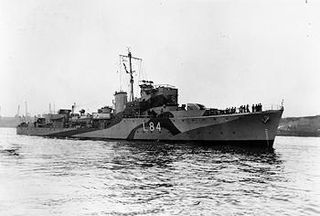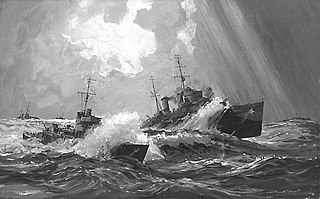
HMS Jackal was a J-class destroyer of the Royal Navy. Completed in 1939, Jackal served in the Norwegian campaign and the Dunkirk evacuation before being deployed to the Mediterranean in 1941. Jackal took part in the Battle of Crete, and was scuttled after being heavily damaged by German bombers on 12 May 1942.

HMS Hero was an H-class destroyer built for the Royal Navy in the mid-1930s. During the Spanish Civil War of 1936–1939 the ship enforced the arms blockade imposed by Britain and France on both sides as part of the Mediterranean Fleet. During the first few months of World War II, Hero searched for German commerce raiders in the Atlantic Ocean and took part in the Second Battle of Narvik during the Norwegian Campaign of April–June 1940 before she was transferred to the Mediterranean Fleet in May where she escorted a number of convoys to Malta. The ship took part in the Battle of Cape Spada in July 1940, Operation Abstention in February 1941, and the evacuations of Greece and Crete in April–May 1941.

HMS Hursley was a Second World War Type II Hunt-class escort destroyer of the British Royal Navy. She is the only Royal Navy ship to have carried this name. Hursley is a village in Hampshire. Commissioned in 1942, she served in the Mediterranean, before being transferred to the Hellenic Navy in November 1943 and renamed Kriti. She took part in the landings in Sicily, Anzio, and southern France, and remained in Greek service until 1959.

HMS Nubian was a Tribal-class destroyer of the Royal Navy that saw much distinguished service in World War II. She won 13 battle honours, a record only exceeded by one other ship, and matched by two others.

HMS Paladin was a P-class destroyer of the Royal Navy that served in the Second World War. She was built by John Brown and Co. Ltd., Clydebank. She saw action in the Mediterranean and Far East. After the war she was converted into a type 16 frigate and was eventually scrapped in 1962.

HMS Beaufort was a Hunt-class destroyer of the Royal Navy. She was laid down on 17 July 1940 at Cammell Laird, Birkenhead. She was launched on 9 June 1941 and commissioned on 3 November 1941. During the Second World War the ship served in the Mediterranean Sea, escorting convoys and covering landings. She was transferred to the Royal Norwegian Navy in 1952 and scrapped in 1965.

HMS Wrestler (D35) was a V and W-class destroyer built by the Royal Navy during the First World War and active from 1939 to 1944 during the Second World War. She was the first Royal Navy ship to bear that name, and the only one to do so to date.

HMS Lively was an L-class destroyer of the Royal Navy. She served during the Second World War, and was sunk in the Mediterranean in an air attack on 11 May 1942.

HMS Westcott (D47) was a Royal Navy Admiralty W-class destroyer that served in the Second World War. In the Second World War Westcott served in an anti-submarine role and escorted numerous Atlantic and Malta convoys.

HMS Derwent was a Hunt-class Type III escort destroyer of the Royal Navy. She was built by Vickers-Armstrongs, in Barrow-in-Furness, and served during the Second World War. In March 1943, she was badly damaged while anchored in Tripoli harbour by aircraft and beached to prevent her from sinking. Temporarily repaired and towed to England, further repair work was halted in January 1945, and she was broken up for scrap in 1947.

The second HMS Exmoor (L08), ex-HMS Burton, was a Hunt-class destroyer of the Royal Navy in commission from 1941 to 1945. She was a member of the second subgroup of the class, and saw service during much of World War II. She later served in the Royal Danish Navy as HDMS Valdemar Sejr.

HMS Albrighton was a Type III Hunt-class destroyer built for the British Royal Navy. She entered service in February 1942, first carrying out an attack on German ships in the English Channel then taking part in the Dieppe Raid, rescuing survivors from the sinking destroyer HMS Broke. Albrighton was next assigned to search for and destroy the German auxiliary cruiser Komet, then escorted a convoy to Gibraltar in prevision of the Allied landings in North Africa. Between December 1942 and April 1943, she participated in the sinking of three more Axis ships with the First Destroyer Flotilla. During the Normandy Landings in June 1944, Albrighton served as a headquarters ship, then sank two German trawlers in the weeks after the invasion. After being converted to a destroyer in early 1945, she was damaged in a collision with a Landing Ship, then was assigned to the British Eastern Fleet. However, the war ended before she was deployed and Albrighton went into reserve.

HMS Atherstone was a Hunt-class destroyer of the Royal Navy. She was launched in late 1939 as the first of her class but was found to be unstable, and had to undergo significant modifications before entering service in March 1940.

HMS Douglas was an Admiralty type flotilla leader of the British Royal Navy. Built by Cammell Laird, Douglas commissioned in 1918, just before the end of the First World War. During the Second World War, Douglas served with Force H out of Gibraltar and as a convoy escort. She was sold for scrap in March 1945.

HMS Berkeley was a Type I Hunt-class destroyer of the Royal Navy. She was a member of the first subgroup of the Hunt class and saw service in World War II before being bombed at Dieppe and then scuttled by HMS Albrighton.

HMS Campbell was an Admiralty type flotilla leader of the British Royal Navy. Built by Cammell Laird, Douglas commissioned in December 1918, just after the end of the First World War. During the Second World War, Campbell mainly served with as a convoy escort, particularly on the East Coast of the United Kingdom. She survived the war, and was sold for scrap in 1947.

HMS Limbourne (L57) was a Hunt-class escort destroyer, operated by the Royal Navy. She was sunk in action, off German-occupied Guernsey, on 23 October 1943.
HMS Rockwood was a Type III, Hunt class Escort destroyer of the Royal Navy, built by Vickers-Armstrongs in Barrow-in-Furness and served during the Second World War. She was damaged in action in November 1943 by a glide bomb, not fully repaired, took no further part in the war and was broken up for scrap in 1946.

HMS Easton was a Type III Hunt-class destroyer of the British Royal Navy. Easton was built by the shipbuilder J Samuel White in 1941–1942, being launched on 11 July 1942 and completed on 7 December 1942.

HNoMS Eskdale was an escort destroyer of the Type III Hunt class. The destroyer served with the Royal Norwegian Navy. It was sunk by enemy action in 1943.



















